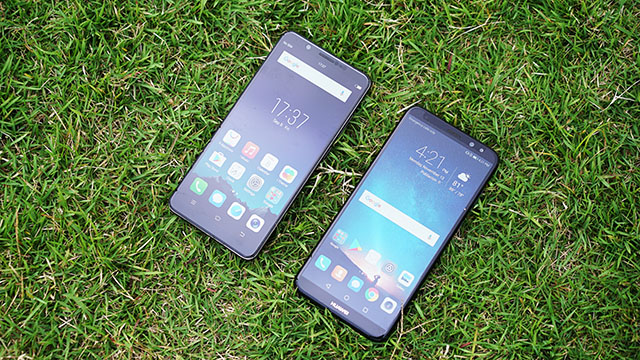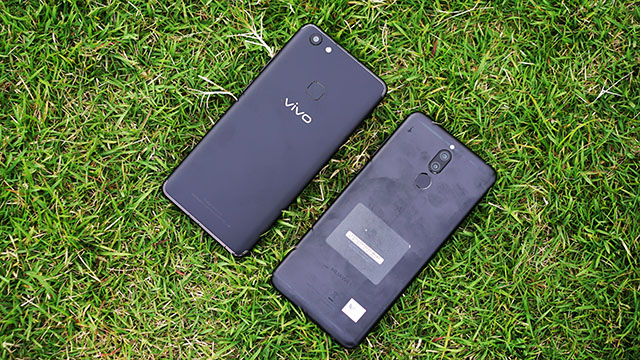For this head-to-head matchup, the Huawei P and Mate’s impressive little brother, the Nova 2i, clashes with the red-hot Vivo V7 Plus! Despite being considered a budget phone, will the Huawei Nova 2i have enough in the tank to be a good match for Vivo’s newest selfie master?
Round 1: Cameras
From the get-go, we see that the Vivo dominates the selfie camera battle, with a ‘Moonlight’ Glow flash complementing the 24-megapixel front camera. Not only does it have the higher megapixel count, but it also touts a better sensor and a better aperture. This isn’t to say that the Huawei Nova 2i’s front shooter is bad. In fact, the 13-megapixel plus 2-megapixel duo with soft flash does well on its own. Plus, it will definitely satisfy most consumers.
The rear camera, on the other hand, provides a closer race, with both devices touting a 16-megapixel lens. However, the Nova 2i gets the advantage here by providing the same dual lens setup and a dual-tone flash. This means that the Nova 2i should produce images with better-quality colors, blacks, and whites. Plus, the dual-tone flash should result in better rear-camera photos for low-light situations. Furthermore, the dual lens setup also lends to a strong bokeh effect, which becomes evident as one becomes accustomed to the camera app. Basically, it appears that the Huawei Nova 2i’s camera strength lies in the quad-lens camera setup. It’s something that’s rarely seen in its competitors, after all.
Overall, it falls to the question of whether or not you want a selfie-centric phone or a balanced experience. Obviously, if you need a device that will fill your instagram or Facebook with high-quality selfies and groufies, the V7 Plus answers your needs. Conversely, if you want a phone that takes great photos on both ends, and features a quad-lens camera set with a great bokeh effect, the Nova 2i works well.
Round 2: Performance
On paper, the octa-core Snapdragon 450 gets into a close tie with the Nova 2i’s Kirin 659 octa-core. In my opinion though, I prefer the Huawei’s EMUI over Funtouch. Simply put, I enjoyed the simple design and easy-to-use interface of the EMUI. The Funtouch isn’t bad, though, and will not alienate users who might be used to stock Android. Again, this falls to a matter of preference.
It should be noted, however, that the V7 Plus’ iteration of Funtouch builds upon a more recent version of Android Nougat (7.1 versus EMUI’s 7.0). Besides that, both smartphones tout the same kind of RAM, measuring at 4GB. Additionally, they also give a generous amount of internal storage, with an expendable 64GB.
Round 3: Everything Else
The last thing we looked at are the display, the overall build, and the battery life. In terms of the display size, the V7 Plus edges out by measuring as close to six inches as possible. Considering the numbers, it gets a 0.09 inch advantage over the 5.9-inch Nova 2i. However, the Nova 2i makes up for this with an FHD display, which might be a bit better than the Incell FullView HD display of the Vivo. As mentioned before, it falls to what looks better to the user.
Another clear advantage for Huawei lies in the battery life. At 3,340mAh, it theoretically lasts longer than the Nova 2i’s 3,225mAh battery. From experience, both devices efficiently consume the charge, so neither phone feels like they’re draining the battery. I’d say this one is a close tie.
For the overall build, both smartphones look and feel like premium devices. This actually seems even more impressive for the Nova 2i, which advertises itself as a budget option for Huawei fans. Plus, even though Leica did not get involved in the Nova 2i’s camera engineering, the device makes you think that it did. How? By making sure it doesn’t look cheaper than its P and Mate cousins. On the other hand, the Vivo V7 Plus continues the design principles from earlier models, and not straying too far from it.
Summary
In the end, it falls to what you exactly want from your smartphone. The Vivo V7 Plus will surely give you an outstanding selfie experience. In addition, its other specs will satisfy most of your needs. Meanwhile, the Huawei Nova 2i will give you a balanced, Huawei-level experience without breaking the bank. Honestly, I would recommend both smart devices to anyone.
Huawei Nova 2i Specs
| OS | EMUI 5.1 (Android 7.0 Nougat) |
| Processor | Octa-Core Kirin 659 processor (4 xA53 at 2.36GHz + 4 x A53 at 1.7GHz) |
| Memory | 4GB |
| Display | 5.9-inches FHD |
| Storage | 64 GB, expandable to 256 GB |
| Front Camera | 13MP front camera with soft LED flash, secondary 2MP camera |
| Rear Camera | 16MP rear camera with dual-tone LED flash, secondary 2MP camera |
| Battery | 3,340mAh battery |
| Dimensions | 156.2 u00d7 75.2 u00d7 7.5 mm |
Vivo V7 Plus Specs
| OS | Android 7.1 Nougat (FunTouch 3.2 OS) |
| Processor | Qualcomm Snapdragon 450 SoC, octacore |
| Memory | 4GB |
| Display | 5.99-inch HD (720x1440 pixels) IPS Incell 'FullView' display |
| Storage | Expandable 64GB on-board storage (up to 256GB) |
| Camera | 16-megapixel rear camera + 24-megapixel front camera with an f/2.0 aperture, 1/2.78-inch sensor, and a 'Moonlight Glow' soft selfie light |
| SIM | Dual-SIM (Nano) |
| Battery | 3,225mAh |
| Audio | AK4376A Hi-Fi chipset |
| Dimensions | 155.87 x 75.47 x 7.7 mm |
| Weight | 160 g |


